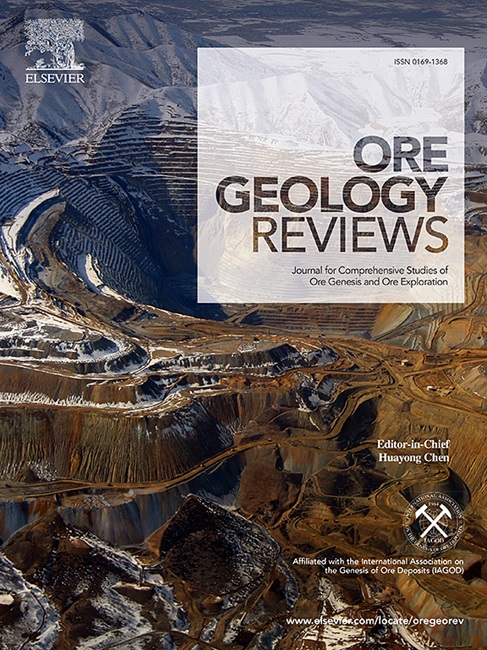滇西腾冲地体构造岩浆演化与锡矿化意义:来自地球化学和白垩纪花岗岩类Sr-Nd-Hf同位素的证据
IF 3.6
2区 地球科学
Q1 GEOLOGY
引用次数: 0
摘要
腾冲地体早白垩世至晚白垩世花岗岩类对中特提斯和新特提斯洋的构造演化及其多金属成矿作用具有重要意义。本文采用岩石学、地球化学和同位素(Sr-Nd、锆石U-Pb、Lu-Hf)分析方法,对滇滩、古永和小龙河三组岩体及其构造演化进行了研究。锆石U-Pb定年结果显示,滇滩花岗斑岩年龄为116.5 Ma,古永黑云母花岗岩年龄为71.8 Ma,小龙河二长花岗岩年龄为76.5 Ma,小龙河花岗闪长岩年龄为66.4 Ma。地球化学资料显示,早白垩世花岗岩为s型,晚白垩世花岗岩为a型,反映了同碰撞向碰撞后伸展的过渡。负锆石εHf(t)值(- 3.1 ~ - 14.9)和两阶段模式年龄(TDM2 = 1.17 ~ 2.03 Ga)表明中元古代和古元古代地壳物质的掺入。Sr同位素比值(初始87Sr/86Sr(i)值在0.709662 ~ 0.725917之间)表明形成于非均质源,包括火成岩和变质沉积岩。富锡重熔地层和多阶段分异结晶作用的显著贡献解释了小龙河和来立山含锡花岗岩含矿性质的差异。这些发现凸显了腾冲—两河地区在多期岩浆作用和丰富的深部锡矿资源的驱动下具有很强的锡矿化潜力。本文章由计算机程序翻译,如有差异,请以英文原文为准。

Implications for tectono-magmatic evolution and tin mineralization in Tengchong terrane, western Yunnan, China: Evidence from geochemistry and Sr-Nd-Hf isotope of Cretaceous granitoids
The early to late Cretaceous granitoids of the Tengchong terrane offer key insights into the tectonic evolution of the Meso-Tethys and Neo-Tethys Oceans and associated polymetallic mineralization. This study employs petrological, geochemical, and isotopic analyses (Sr-Nd, zircon U-Pb, Lu-Hf) to investigate the Diantan, Guyong, and Xiaolonghe plutons and their tectonic evolution. Zircon U-Pb dating reveals ages of 116.5 Ma for the Diantan granite porphyry, 71.8 Ma for the Guyong biotite granite, 76.5 Ma for the Xiaolonghe monzogranite, and 66.4 Ma for the Xiaolonghe granodiorite. Geochemical data show that the Early Cretaceous granites are S-type, while the Late Cretaceous granites are A-type, reflecting a transition from syn-collisional to post-collisional extension. Negative zircon εHf(t) values (−3.1 to −14.9) and two-stage model ages (TDM2 = 1.17–2.03 Ga) indicate incorporation of Mesoproterozoic and Paleoproterozoic crustal material. Sr isotope ratios (initial 87Sr/86Sr(i) values ranging from 0.709662 to 0.725917) suggest formation via melting of heterogeneous sources, including igneous and metamorphosed sedimentary rocks. The significant contribution of remelted tin-rich strata and multi-stage fractional crystallization explains variations in ore-bearing properties of the tin-bearing granites at Xiaolonghe and Lailishan. These findings highlight the strong tin mineralization potential of the Tengchong-Lianghe region, driven by multi-phase magmatism and substantial deep-seated tin resources.
求助全文
通过发布文献求助,成功后即可免费获取论文全文。
去求助
来源期刊

Ore Geology Reviews
地学-地质学
CiteScore
6.50
自引率
27.30%
发文量
546
审稿时长
22.9 weeks
期刊介绍:
Ore Geology Reviews aims to familiarize all earth scientists with recent advances in a number of interconnected disciplines related to the study of, and search for, ore deposits. The reviews range from brief to longer contributions, but the journal preferentially publishes manuscripts that fill the niche between the commonly shorter journal articles and the comprehensive book coverages, and thus has a special appeal to many authors and readers.
 求助内容:
求助内容: 应助结果提醒方式:
应助结果提醒方式:


